Leo E.
114p4,119 comments posted · 369 followers · following 22
10 years ago @ Halolz - WOLF WEDNESDAY RETURNS. · 0 replies · +4 points
RWBY didn't invent yuri shipping... I sure as hell can't even get into the series because of the weird animation and the horrible voice acting. I tried the game on Steam and it was one of the worst things I've ever played.
Plus I see RWBY stuff on Tumblr all the time, and it seems to be one of those things where all the yuri is kept as subtext and undertones. If I'm understanding correctly, they also have potential male love interests as well so they can tease the lesbian relationships while it's convenient and then say "no the real love interest was this guy all along".
That or the fanbase is just reading too far into it in the first place. I'd have to watch it myself to see, but I literally can't sit through the damn thing.
10 years ago @ Halolz - WOLF WEDNESDAY RETURNS. · 0 replies · +8 points
10 years ago @ Halolz - WOLF WEDNESDAY RETURNS. · 0 replies · +7 points
Technically less important than Geno and Chocobos too, since they got Mii costumes.
10 years ago @ Halolz - WOLF WEDNESDAY RETURNS. · 2 replies · +5 points
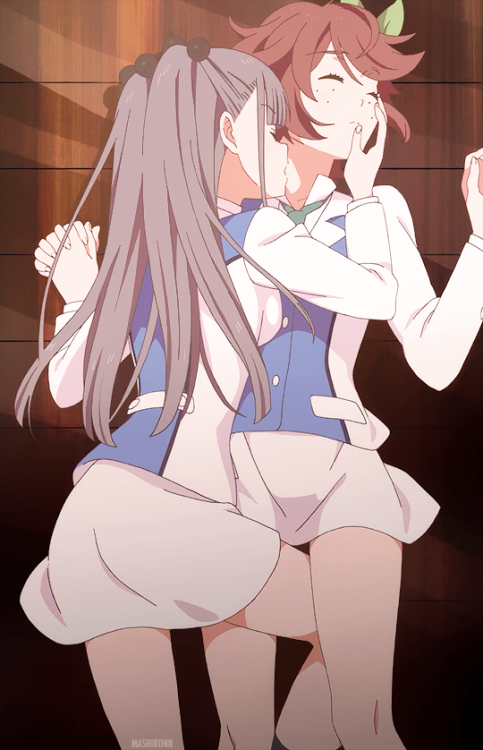


Bitch slept with and/or ate half the cast.
Mind-raped Ginko from beyond the grave.
10 years ago @ Halolz - WOLF WEDNESDAY RETURNS. · 4 replies · +5 points
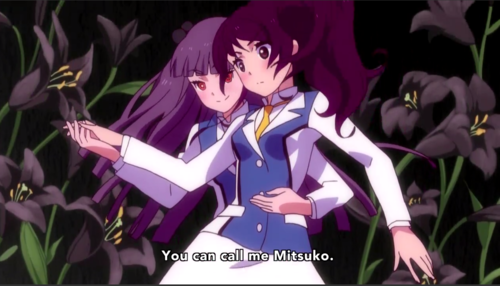
10 years ago @ Halolz - WOLF WEDNESDAY RETURNS. · 5 replies · +5 points
And this is where I have to stop describing the plot because anything past there goes into heavy spoiler territory, and like fuck am I gonna spoil anything about this show, because if there’s one show you should watch right now, it’s this one.
A word of caution, however, one thing that Yurikuma (and all Ikuhara works in general) is heavy on is symbolism. And not just “ooh look this conversation foreshadows the ending”, I mean that almost every frame has at least one example of something that means way more than it shows. Seriously, that’s how I felt BEFORE reading more in-depth analyses and finding out that even I missed about half of it. There are your more obvious ones (metaphors for prejudice and hypocrisy are literally everywhere), but most you’ll have to read a little deeper into. Everything from the location of Kureha’s house and the signs around it, to Sumika’s delicate glasses, and even the shape of the rails on a set of stairs means something, silently contributing copious amounts of information and substance to the overall setting. Even something as heavy-handed as a bear trap in a series full of bears has meaning.

It would take me a little while to go over everything this garden and its flowers mean.
And the best part is that you’ll miss almost all of it. You’ll miss it, recognize it retroactively, go back an episode, and marvel at everything you failed to see before. Every episode is paced perfectly so that the answers just barely escape you. You’ll begin to slowly recognize the symbols, but won’t fully grasp what they’re alluding to. You can start to see which direction the story will go, but can’t imagine how it will unfold. And let me just tell you, those who start the show now will never even remotely understand the pain of waiting a week between episodes.
Along with symbolism, another mainstay of Ikuhara’s works is repetition. Those who watched Utena would obviously remember the Shadow Girls, a trio of faceless girls who would only be shown through their silhouettes near the end of each episode to enact a cryptic play that vaguely alluded the remainder of the episode. In a similar way Yurikuma has the “Judgmens”, a trio of bears that act as judge, prosecution, and defense in a court-themed segment that recurs usually once each episode. Their purpose in the story isn’t quite as obvious as Utena’s Shadow Girls though, and much more surreal.

TL note: shabadadu means shabadadu.
And since I can’t really step too hard on the symbolism and repetition without spoiling, let’s take a step back and talk about the presentation. Even ignoring the symbolic content, the visuals are simply stunning, and seem to have taken visual cues from numerous other sources; for example, the pattern in the Severance Barrier happens to be the same pattern as the rug from the hotel in The Shining, which, knowing Ikuhara, is no coincidence. Environments and backgrounds are beautifully rendered down to every last insignificant detail, and the character design is top-notch.

Color-coded for even more symbolism.
Music is another of Yurikuma’s numerous strong points, with songs as beautiful and whimsical as the series’s tone. The opening theme in particular, “Ano Mori de Matteru” (literally “I’ve Been Waiting in That Forest”) perfectly sums up the show, appearing vulgar and sexual at first glance before taking on deeper meaning as you continue into it. For bonus points, watch the show, consider what Kureha does at the end of the story, then read the song’s title again and have your mind blown.
Yurikuma comes as highly recommended as I can possibly make it. It’s a thrilling, suspenseful, and heartfelt experience from start to finish, and completely unique snowflake in the current blizzard of MMORPG and harem anime.
FINAL SCORE: Gao/Gao
10 years ago @ Halolz - WOLF WEDNESDAY RETURNS. · 6 replies · +5 points

Yuri Kuma Arashi (literally “Lily Bear Storm” in Japanese, but you should know that yuri means gay girls) is an anime series from the delightfully impenetrable mind of Kunihiko Ikuhara, who you may remember from Revolutionary Girl Utena, Mawaru Penguindrum, and the more fucked up episodes of Sailor Moon. If you don’t remember him, you’ll be thoroughly reminded throughout the series, because it has nearly all of his trademark direction choices.

Remember these two?
At its base, Yurikuma is perhaps one of the strangest premises for an anime. To put it bluntly in a run-on sentence, it’s about bears who eat humans, so the humans walled off the bears behind a “Severance Barrier” (which seems to do almost nothing to keep any particularly persistent bear out), and also the bears can take the form of girls and are lesbians, and the context is so incredibly sexual that for a bit you might actually wonder what exactly they mean by “eat”. I should clarify that they do in fact mean the gnashing teeth and the blood and guts and through the mouth into the stomach.
What tends to throw most people off from Yurikuma in the first place is the aforementioned overtly sexual presentation, as it’s not exactly the kind of show you’d be comfortable watching with people in the room. Combine that with its hard-to-describe premise and you’re looking at a show that you can praise constantly for months with absolutely nobody wanting to believe you. But that’s exactly what I’m going to try and do here, because holy fucking shit is this show good.
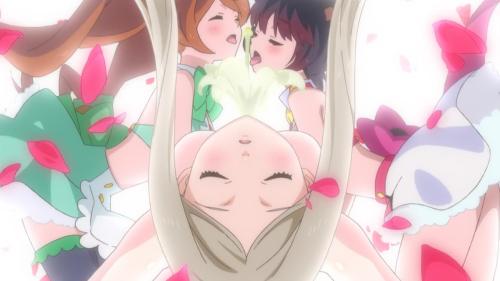
This is a little difficult to explain to an onlooker.
So our story focuses on Kureha Tsubaki (note that her last name has to do with flowers and also has the syllables for ‘moon’ in there as well), a high school girl whose mother was eaten by bears in the past. Naturally she has more than a little animosity toward bears, to the point where she practices daily with a hunting rifle on bear-shaped targets in preparation for the day she meets one.
Well that day has come. Two bears named Ginko Yurishiro (note that Ginko’s name is very similar to the ginkgo tree) and Lulu Yurigasaki take human form and join Kureha’s school with their sights set on Kureha. Though initially they seem to want to eat Kureha, it quickly becomes clear that Ginko wants to do far more than just that to her.
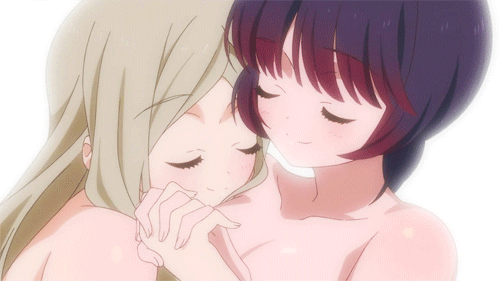
Disgusting hand-holding, for starters.
Also starring for a whole ten minutes is Sumika Izumino, Kureha’s gentle-hearted bespectacled girlfriend. She is introduced just long enough to show that she and Kureha are in love, before she is promptly killed and devoured by bears, presumed to be Ginko and Lulu. But since this is an Ikuhara anime, the fact that she’s is dead in no way means she’s out of the story. Numerous flashbacks continue to flesh out her character and her influence on the events of the story, many of which consist of her and Kureha naked in the latter’s bed together.
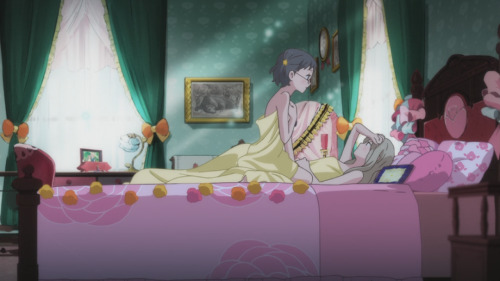
Just girly things.
10 years ago @ Halolz - WOLF WEDNESDAY RETURNS. · 0 replies · +6 points
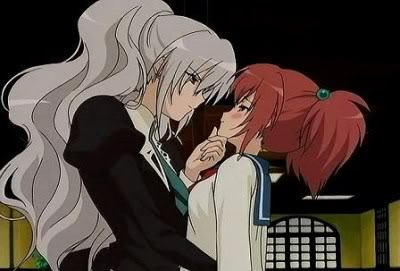
She’s basically lesbian Dracula, except instead of sucking your blood she sucks your clit.
Nagisa begins to acclimate herself to her new surroundings, and discovers that Shizuma has slept with and broken the heart of roughly 105% of the girls at Miator, give or take 5%. Something about her glorious silver hair and goddess-tier beauty lets her open other girls’ legs easier than a can of soda. And just like cans of soda, Shizuma is all to eager to use them up and toss them in the recycling bin. But Nagisa, drunk on a mixture of main character confidence and Shizuma’s pheromones, decides to approach her again. After all, the transfer student and the most popular student always end up together, right?
Strawberry Panic tries to deliver quite a few things. Comedy, romance, drama, intrigue, angst, more romance, heartbreaking tragedy, and, naturally, lesbians. And believe it or not, it succeeds at pretty much all of those. Perhaps even more impressive than its delivery of all those aspects is how it manages to transition between them. The show actively uses the three-school system to naturally change tone on a dime. You can be watching a serious emotional scene between Shizuma and Miyuki, then cut to a couple of girls wearing Lulim’s uniform and you automatically know it’s comic relief time. This is a necessity for a show that attempts to tell the stories of so many characters, as it helps the viewer to more easily associate each different plot with one of the three schools.
Strawberry Panic also avoids some of the usual pitfalls of yuri anime. It doesn’t limit the characters’ relationships to subtext, and you’d be hard-pressed to find an instance of “b-but we’re both girls!”. Nor would that work anyway. Shizuma knows you’re a girl. It’s what gets her off.

Pussy destroyer.
Naturally as a yuri anime, Strawberry Panic’s main value comes from its characters. A great amount of depth is given to the more prominent characters, except for Amane who both starts and ends as boring as a board of styrofoam. Shizuma’s character in particular is explored thoroughly through a series of flashbacks that shape her into the person we see in the current story, and I found this to be the most enjoyable part of the series. Also noteworthy is Yaya, who starts out relatively happy and content, before we get to see her systematically, efficiently, and brutally torn apart throughout the course of the series.

Strawberry Panic drinking game: drink every time Yaya smiles despite being dead inside.
Visuals are perhaps the weakest point of the series. As a product of its time, Strawberry Panic’s mid-2000s art style really works against it in many situations. Though the scenery is quite beautiful, character design really fails to impress. Over-exaggerating and under-exaggerating all of the wrong features results in some silly visuals, especially for distant characters or lower-budget scenes. And even your normal scenes are saddled with odd design choices.

She’s so 2000s her uniform’s shoulders are stuffed with Sudoku puzzle books.
The music tends to help where the visuals fail, though. Strawberry Panic’s soundtrack is stunning and hits every type of music you’ll need, from the happy-go-lucky comedy scenes to the tragic emotional scenes.
All in all Strawberry Panic is a wonderful experience, with plenty of twists and turns to keep you interested despite a small lull about halfway through the series. The romance between Nagisa and Shizuma is paced perfectly to keep a “will they/won’t they” vibe going up until the very end, and manages to do so without becoming tiresome or predictable, which is more than can be said for 90% of other romance couples.
FINAL SCORE:
Gay/10
Tune in next month where we'll tackle some other gay shit if the site hasn't updated yet. Which we all know it won't.
10 years ago @ Halolz - WOLF WEDNESDAY RETURNS. · 1 reply · +5 points
I quickly decided against that. So here's a review of a yuri anime.
---

Strawberry Panic (usually stylized as “Strawberry Panic!” but like fuck am I gonna put the exclamation mark every time I say it) is a yuri anime series by Studio Madhouse based on the manga based on the light novels by Sakurako Kimino, a novelist who would later continue her gay exploits with the immensely-popular and marginally-less-gay Love Live! Series (Kimino seems to have a thing for exclamation marks). Yes, I said less gay. Nozomi and Eri may be going down on each other every time they go out for parfaits, but they’ve never done half the shit that Strawberry Panic’s girls have done on-screen.

Love Live’s Umi Sonoda watching Strawberry Panic.
Though mostly focusing on a pair of characters named Nagisa and Shizuma, Strawberry Panic encompasses the stories of a dozen or so girls, each gayer than the one before them as long as you put Shizuma last. They all attend a loosely-affiliated trio of schools on Astraea Hill that share the same campus and housing, and therefore get to be uniform-coded to help you remember them better. By name, the schools are Miator, Spica, and Lulim.
Miator is the school of main characters. Series focal points Nagisa Aoi and Shizuma Hanazono both attend Miator, as well as Nagisa’s totally platonic roommate Tamao Suzumi, Shizuma’s booty call Miyuki Rokujou, and the easily-forgettable kouhai Chiyo Tsukidate. When elections are held for the “etoile” position (basically lesbian prom queen but for the whole year), Miator’s candidates’ win percentages hover somewhere around 100%. To put it bluntly, they’re so important that their school motto is “If it ain’t happening here, it’s a sub-plot.”
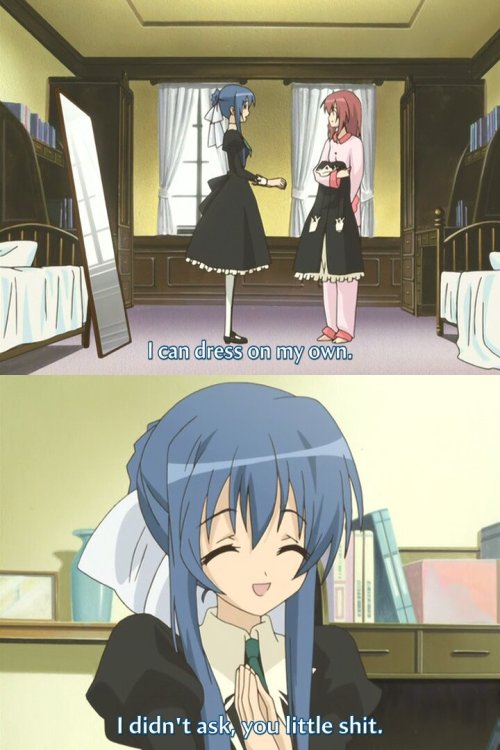
“You’re in my house now, Nagisa.”
Spica is the school of stuck-up bitches. They have a lovely choir that is also full of stuck-up bitches. Breaking through the crowd of stuck-up bitches are delicate flower Hikari Konohana (RIP Miyu Matsuki) and lovable delinquent Yaya Nanto, who both not-so-coincidentally happen to be members of said choir. Oh and there’s also Amane Ootori who is boring as fuck. Spica’s student council president Shion Toumori also gets some screen time here and there to try and steal the next Etoile election from Miator, but aside from that she doesn’t really do much. Also hailing from Spica is the shitty tsundere Tsubumi Okuwaka. And let’s not forget the two worst bitches in the world Kaname Kenjou and Momomi Kiyashiki. Did I mention that they are the two worst people alive? Because it comes up. A lot.

What a lovely couple Yaya and Hikari make. I’m sure there’s nothing but happy days ahead for them.
Lulim is the proud comic relief school. They’re unimportant, but they know it, and they thrive on it. Taking center stage here is Chikaru Minamoto, along with her two underlings Kizuna Hyuuga and Remon Natsume. Another girl named Kagome Byakudan also attends Lulim, and serves to fill the show’s creepy child quota. The first three spend 90% of the series running around in the background doing crazy things and being useless, and the other 10% of the time having threesomes together. Chikaru spends any free time being Yuri Santa Claus, often working behind the scenes to hook up other couples.

Imagine Hitch, but gayer and without a Y chromosome.
10 years ago @ Halolz - WOLF WEDNESDAY RETURNS. · 1 reply · +8 points
How does it feel to be worth less than Mii Fighters, the Koopalings, and goddamn male Wii Fit Trainer.
 Company
Company